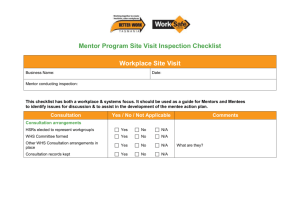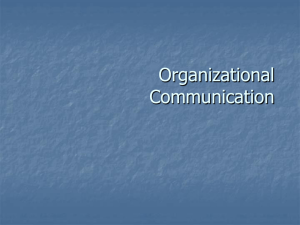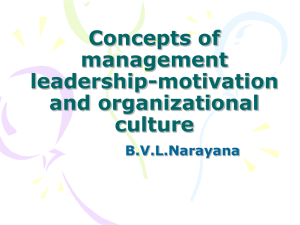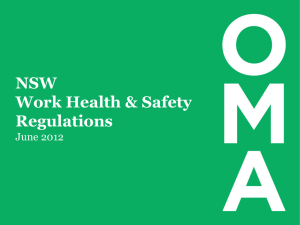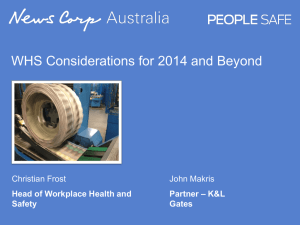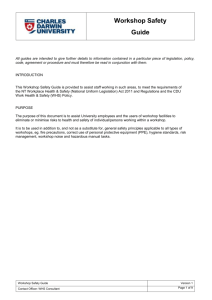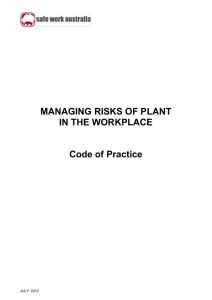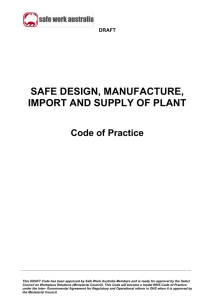Small Business Implication - Consulting Surveyors NSW :: Admin
advertisement
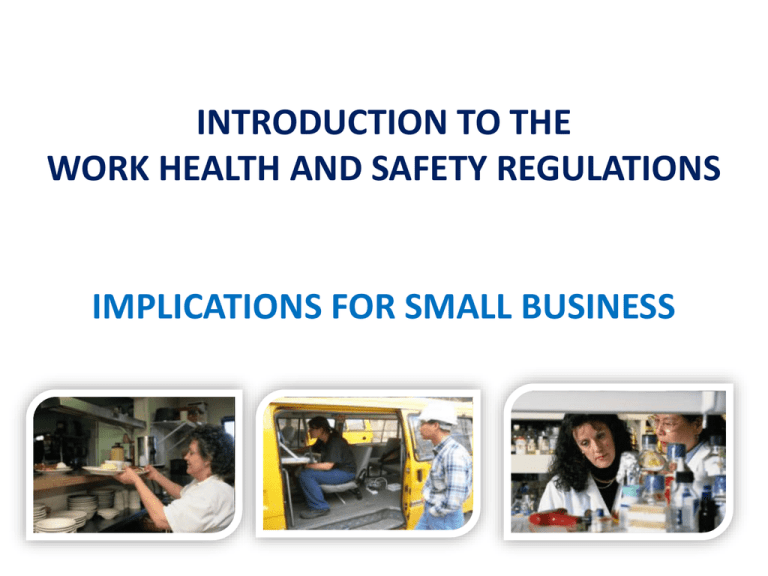
INTRODUCTION TO THE WORK HEALTH AND SAFETY REGULATIONS IMPLICATIONS FOR SMALL BUSINESS WHAT HAS CHANGED? • Work Health and Safety Act will replace the NSW OHS Act • Work Health and Safety Regulations will replace the current NSW OHS Regulation • A set of national Codes of Practice will gradually be introduced For most workplaces the new WHS Regulations will be very similar to the current OHS Regulation WHAT’S COVERED IN THE WHS REGULATIONS PRELIMINARY REPRESENTATION AND PARTICIPATION GENERAL RISK & WORKPLACE MANAGEMENT HAZARDOUS WORK PLANT AND STRUCTURES WHAT’S COVERED IN THE WHS REGULATIONS CONSTRUCTION WORK HAZARDOUS CHEMICALS ASBESTOS MAJOR HAZARDOUS FACILITIES MINES GENERAL Managing Risks •Must identify and eliminate or control risks •Must eliminate risks and if not reasonably practicable minimise risks •Risks unable to be eliminated must be controlled through a hierarchy of control •Risk assessment is not mandatory in most cases – outcome focused Managing Risks • Must maintain and review risk control measures • HSRs can request a review of a control measure in certain circumstances • Where specific controls are outlined in the WHS Regulations they must be followed (e.g. controls for hazardous chemicals or noise) Training, Information and Instruction Must be suitable and reflect: • The nature of the work carried out by the worker • The nature of the risks associated with the work • The control measures implemented Consultation and Representation • WHS Act includes key requirements • WHS Regulations: − Outlines the factors in determining work groups − Specifies HSR training details • Code of Practice provides further guidance Issue Resolution Procedure must take into account: the degree and immediacy of risk to workers or other persons involved in the issue; the number and location of workers and other persons affected by the issue; the measures (both temporary and permanent) that must be implemented to resolve the issue; who will be responsible for implementing the resolution measures Working Environment • Workplace layout allows persons to move around and access and exit without risk • Work space is adequate for the task • Floors and other surfaces are suitable • Lighting and ventilation is suitable • Work in temperature extremes is without risk • Work near essential services does not create risks Facilities Must provide facilities including toilets, drinking water, washing and eating facilities relevant to: •The nature of the work •The hazards in the workplace •The size, location and nature of the workplace •The number and composition of workers Personal Protective Equipment • Must be appropriate to the activity and hazard • Must be a suitable size and fit and maintained and replaced as required • Workers must be informed and trained on PPE use First Aid • Must provide accessible First Aid equipment and facilities • Ensure adequate numbers of workers are trained or have access to others who are trained • First Aid arrangements must take into account • The nature of the work • The hazards in the workplace • The size, location and nature of the workplace • The number and composition of workers (and others) 13 Emergency Plan • Must include procedures for rapid response, evacuation, notification, medical assistance and communication • Must inform workers of procedures • Must be tested in line with plan schedules • Emergency plan must take into account − The nature of the work − The hazards in the workplace − The size, location and nature of the workplace − The number and composition of workers (and others) Short case study exercises No 1 Case 1 Issues to consider A small business employs 20 people. The injury register shows lacerations and burns are the most frequently recorded injury. • What is the size and layout of the workplace? • Is the workplace in close proximity to medical services or hospitals? • Do any workers work off site? The existing NSW regulations mandating number of first aiders, kit numbers and contents will not be continued in the new WHS Suggested Conclusions regulation. What First Aid arrangements are likely to be adequate? • An assessment should be undertaken • If the workplace is compact then kits can be located in the main operating areas • If already complying with the existing NSW regulations a kit, suitably stocked and a trained first aider should already been in place. Arrangements for off site workers and an additional burns module for the kit may be required Falls Manage the risk of a fall by a person from one level to another by: • Ensuring so far as is reasonably practicable that any work that involves the risk of a fall is carried out on the ground or on a solid construction • Providing safe access to and exit from the workplace or any area within the workplace with the risk of a fall Falls If not reasonably practicable to eliminate the risk of falling then minimise the risk by providing adequate protection such as (in order): • Providing a fall prevention device or • Providing a work positioning system, or • Providing a fall arrest system Hazardous Manual Tasks Take into account risk factors including: •Postures, force, duration and frequency •Workplace environmental conditions, design and layout of workplace •Systems of work used •Nature, size, weight and number of persons, animals or things involved in the hazardous manual task Remote or Isolated Work •Must manage risks to the health and safety of a worker associated with remote or isolated work •Must provide a system of work that includes effective communication with the worker Noise •Ensure that a worker is not exposed to noise levels above the exposure standard •Provide audiometric testing if the worker is frequently required to use hearing protection to reduce exposure to noise and in combination with other factors Short case study exercises No 2 Case 2 Issues to consider A tree faller employed by a small landscaping company uses a chain saw to fell trees with work days as long as 10 hours. • Has the noise level been checked? The faller has been supplied with hearing protection and uses it in line with instructions. The chain saw generates noise above the exposure standard set out in the WHS regulations • How long does the worker use the chain saw for on an average day? • Is the hearing protection appropriate and well maintained? Suggested Conclusions • Should the tree faller have his hearing tested and monitored with audiometric testing? • • The noise is above the exposure standard and the worker should be consulted about audiometric testing Testing should be carried out by qualified persons and results made available Depending on results measures should be taken to reduce exposure (e.g. better maintenance of saw, up-rated hearing protection) Airborne Contaminants • Must ensure exposure standard for a substance or mixture is not exceeded • Must undertake atmospheric monitoring of contaminants in certain circumstances • Must keep records and make accessible to those exposed to contaminants Hazardous Atmospheres • Must manage risks associated with hazardous atmospheres • Must manage risks associated with an ignition source in a hazardous atmosphere • Must ensure that flammable or combustible substances are kept at the lowest practicable quantity Falling Objects •Must manage risks of falling objects if reasonably likely to injure a person •If not possible to eliminate risk then minimise risks to health and safety by: − Preventing free fall of objects − Arresting free fall of object (e.g. barriers, safe means of lowering objects) Some things may appear to be missing Welding Abrasive blasting Licensing for load shifting equipment Some construction hazards e.g.: overhead protective structures, structural collapse, lowering of materials GENERAL DUTIES Spray Painting Certificates of competency for pest controllers Identification and Management of Risk What is reasonably practicable - state of knowledge Short case study exercises No 3 Case 3 Issues to consider A panel shop regularly undertakes spray painting of vehicles with two- pack paint . They use a booth built to Australian Standards and use relevant protective equipment. • How does the Managing Risk section of the regulation apply? Spray painting will no longer be specifically regulated under the new WHS regulations. • How does the airborne contaminants section of the regulation apply? • Are there any other section of the regulation that apply? Suggested Conclusions Does this mean the panel shop should conclude that the process has been de-regulated and that there are no requirements to meet? • • • Spray painting must continue to be undertaken without risk to health and safety The hazards must be identified and risk controls used – the airborne contaminants, hazardous chemicals and lead process sections may all apply Existing practices based on previous regulation and authoritative guidance will form the basis of the state of knowledge Approved Codes of Practice A practical guide to achieve the standards of health and safety required under the Work Health and Safety (WHS) Act and Regulations Provide duty holders with guidance on effective ways to manage work health and safety risks What is the legal effect of Codes of Practice? • Admissible in court proceedings under the WHS Act and Regulations • May be relied on by courts as evidence of what is known about a hazard, risk or control and in determining what is reasonably practicable • Designed to be used in conjunction with the WHS Act and Regulations but do not have the same legal implications • WHS Act and Regulations may be complied with by following another method if it provides an equivalent or higher standard • An inspector may refer to an approved Code of Practice when issuing an improvement or prohibition notice Codes of Practice PRIORITY CODES How to manage work health safety risks WHS Consultation, Cooperation & Coordination Managing work environment and facilities Hazardous manual tasks Confined spaces How to prevent falls at workplaces Preparation of safety data sheets for hazardous chemicals Labelling workplace hazardous chemicals How to manage and control asbestos in the workplace How to safely remove asbestos WHS Regulation Managing noise and preventing hearing loss at work Second Stage Codes of Practice and Guidance Material First Aid in the Workplace Demolition Work Managing Risks in Construction Work Spray Painting and Powder Coating Preventing Falls in Housing Construction Abrasive Blasting Managing Electrical Risks at the Workplace Welding and Allied Processes Managing Risks of Hazardous Chemicals Safe Access in Tree Trimming and Arboriculture Managing Risks of Plant in the Workplace Preventing and Managing Fatigue in the Workplace Safe Design of Building and Structures Preventing and Responding to Workplace Bullying Excavation Work Transitional arrangements and WorkCover NSW Codes Existing NSW Codes of Practice can continue to operate until replaced by national Codes of Practice or guidance materials Where NSW has a Code of Practice on issues that are not specifically regulated, these Codes will become guidance material and must be considered when deciding what is “reasonably practicable” Questions - Please!
